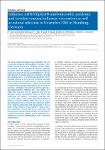Influenza A(H1N1)pdm09 antibodies after pandemic and trivalent seasonal influenza vaccination as well as natural infection in November 2010 in Hamburg, Germany
Cramer, J. P.
Mac, T.
Hogan, B.
Stauga, S.
Eberhardt, S.
Wichmann, Ole
Mertens, Thomas
Burchard, G. D.
The 2009 influenza pandemic has introduced the new re-assorted influenza A(H1N1)pdm09 virus which recirculated during the 2010/11 influenza season. Before that season, it was possible to acquire protective immunity either by pandemic or seasonal influenza vaccination against influenza A(H1N1)pdm09 or by natural infection. To obtain data on vaccination coverage and antibody levels in a reference population and to calculate whether or not the herd immunity threshold (HIT, calculated as 33% given an R0 of 1.5) was reached at the beginning of the 2010/11 season we performed a seroprevalence study in November 2010 in Hamburg, Germany. Antibody titres were assessed applying a haemagglutination inhibition test. Vaccination coverage was very low: 14% for pandemic and 11% for seasonal 2010/11 vaccinations. Even in those with underlying risk factors, vaccination coverage was not much higher: 17% for both vaccines. Serological analysis revealed antibody titres of ≥1:10 in 135 of 352 (38%) and of ≥1:40 in 61 of 352 study participants (17%). Specific antibodies were measurable in 26% of those without history of vaccination or natural infection, indicating a high proportion of subclinical and mild influenza disease. Nevertheless, the HIT was not reached, leaving the majority of the population susceptible to influenza A(H1N1)pdm09 and its potential complications.
No license information
Related Items
Show related Items with similar Title, Author, Creator or Subject.
-
2016-02-18ZeitschriftenartikelVaccine effectiveness in preventing laboratory-confirmed influenza in primary care patients in a season of co-circulation of influenza A(H1N1)pdm09, B and drifted A(H3N2), I-MOVE Multicentre Case–Control Study, Europe 2014/15 Valenciano, Marta; Kissling, Esther; Reuss, Annicka; Rizzo, C.; Gherasim, A.; Horváth, Judit K.; Domegan, L.; Pitigoi, Daniela; Machado, Ausenda; Bella, A.; Paradowska-Stankiewicz, I.; Larrauri, A.; Ferenczi, A.; O´Donell, Joan; Lazar, M.; Pechirra, P.; Korczyńska, M. R.; Pozo, Francisco; Moren, A.Influenza A(H3N2), A(H1N1)pdm09 and B viruses co-circulated in Europe in 2014/15. We undertook a multicentre case–control study in eight European countries to measure 2014/15 influenza vaccine effectiveness (VE) against ...
-
2016-10-13ZeitschriftenartikelImproving influenza virological surveillance in Europe: strain-based reporting of antigenic and genetic characterisation data, 11 European countries, influenza season 2013/14 Broberg, E.; Hungnes, Olav; Schweiger, Brunhilde; Prosenc, Katarina; Daniels, R.; Guiomar, R.; Ikonen, N.; Kossyvakis, A.; Pozo, Francisco; Puzelli, S.; Thomas, I.; Waters, A.; Wiman, Å.; Meijer, AdamInfluenza antigenic and genetic characterisation data are crucial for influenza vaccine composition decision making. Previously, aggregate data were reported to the European Centre for Disease Prevention and Control by ...
-
2013-02-14ZeitschriftenartikelEarly estimates of seasonal influenza vaccine effectiveness in Europe: results from the i-move multicentre case–control study, 2012/13 Valenciano, M.; Kissling, E.We conducted a test-negative case–control study based in five European sentinel surveillance networks. The early 2012/13 adjusted influenza vaccine effectiveness was 78.2% (95% CI: 18.0 to 94.2) against influenza B, 62.1% ...

